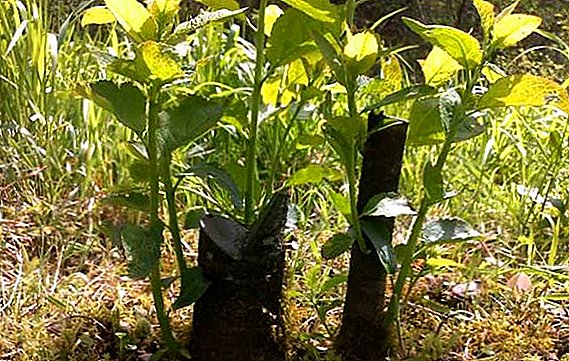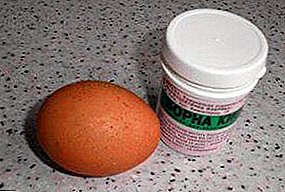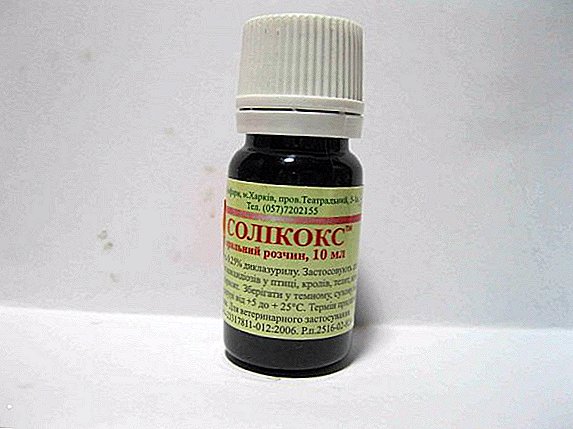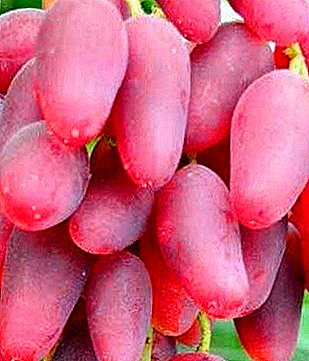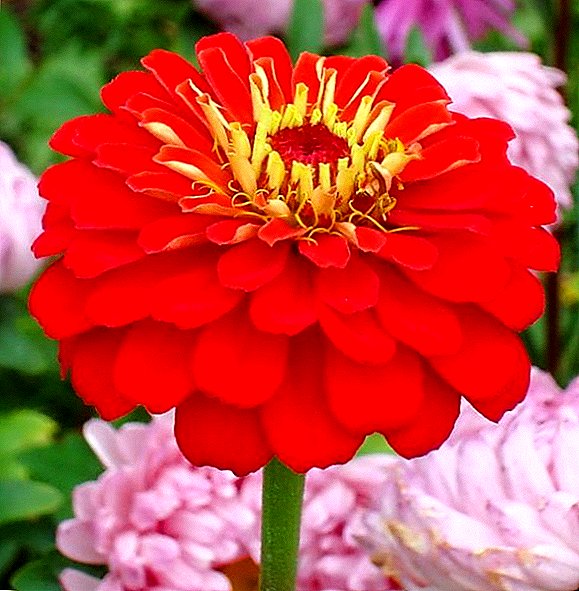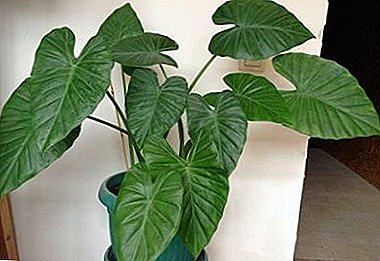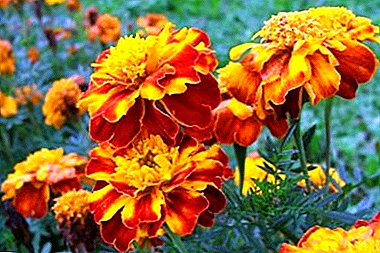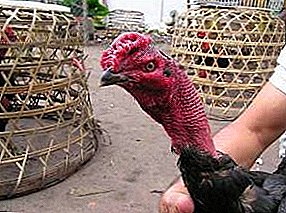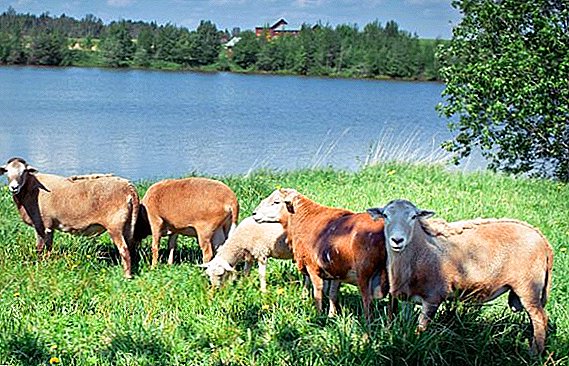 People interested in the development of sheep farming will be interested to get acquainted with a promising young breed of sheep - Katum. The meat of this breed is more like tender veal or beef and does not have the specific taste and smell of lamb. Let's take a look at how to breed Katum sheep at home, what to feed them and how to keep them.
People interested in the development of sheep farming will be interested to get acquainted with a promising young breed of sheep - Katum. The meat of this breed is more like tender veal or beef and does not have the specific taste and smell of lamb. Let's take a look at how to breed Katum sheep at home, what to feed them and how to keep them.
Inference history
The young Russian breed of sheep, the Katum sheep, appeared relatively recently, as a result of directed selection carried out in town of Katuma, located in the Leningrad region. This wonderful breed came from crossing sheep Romanov breed with meat brought from America katadin. That is why it is sometimes possible to hear how the Katum sheep are called kadadin sheep.  This breed was bred as meat. The goal was to get the sheep, for the wool which will not need to care for (wash, cut). This is fully justified by the fact that in the modern world a lot of artificial materials have appeared that heat no worse and sometimes better than wool. That's just the production of synthetic materials costing at times cheaper than obtaining natural wool. Breeding sheep for wool gradually became unprofitable. Sheepskin coats that were once in fashion lost demand, and expensive woolen scarves, sweaters and rugs are made from wool of llamas and mountain alpacs with a fleece of Angora goats or rabbits.
This breed was bred as meat. The goal was to get the sheep, for the wool which will not need to care for (wash, cut). This is fully justified by the fact that in the modern world a lot of artificial materials have appeared that heat no worse and sometimes better than wool. That's just the production of synthetic materials costing at times cheaper than obtaining natural wool. Breeding sheep for wool gradually became unprofitable. Sheepskin coats that were once in fashion lost demand, and expensive woolen scarves, sweaters and rugs are made from wool of llamas and mountain alpacs with a fleece of Angora goats or rabbits.
Check out the breeds of sheep dairy, meat and wool performance.
Description and Features
This species of meat animals differs from other breeds in that it is rapidly gaining weight. For this, katums are sometimes called broiler sheep. The main product derived from them is meat.  Breed features:
Breed features:
- rarely get sick; animals have remarkable immunity;
- short coat, for 9 months without undercoat (appears before winter);
- high fecundity of females;
- quickly gaining conditioned weight;
- not picky in feed;
- have a calm temper.
Sheep do not need to cut, as the winter undercoat sheds in the spring. Avoiding haircuts, animals do not experience stress in the process of separating felted wool. Smooth, like goats, wool helps the Katum sheep to live normally in a humid climate.
Did you know? The sheep was among the first domesticated domestic animals. The tandem between herbivores and man was formed more than eight thousand years ago. The person gave ungulates protection and food in the winter, and the sheep supplied people with meat, skins and milk.
Resistance to diseases in animals at a very high level:
- hoof diseases are extremely rare;
- there are few parasites on the fur (ticks, fleas);
- almost no internal parasites (worms and others).

External data
- Grow at the withers of a ram - 70-75 cm, females slightly lower.
- Male body weight - 100-110 kg, body weight of an ewe - 80 kg.
- Body constitution - meat.
- Body - strong, barrel-shaped, with a wide chest.
- Head - without horns (komolaya).
- Wool - light red or fawn with scattered marks on it slightly brighter or lighter color.
- Tail - length to the middle of the leg.
- Legs - strong, straight, wide set.
- Backbone - powerful, strong.
Read also about the breeds of sheep: Kuibyshev, Gissar, Edilbaev, merino (breed, breeding), dorper, Romney-march.
Weight, earliness and meat quality
The rams of the Katum breed gain body weight up to 110 kg, but there are cases when the weight of a ram approaches 120 kg. Yarochka this breed gaining body weight up to 80 kg. Lambs-katums grow rapidly, and by one and a half years their weight approaches 100 kg.
Meat katumov has all the signs of a lean dietary product. Its taste is unique, the meat is more like veal or young beef. There is no specific taste of mutton, which is facilitated by the structure of the body of the Katumsky sheep. Another unusual property is that in an adult animal meat is no worse than that of a young sheep.  The delicate taste of meat contributes to the following:
The delicate taste of meat contributes to the following:
- The concentration of useful substances and elements that other breeds go to maintain a wool coat (this takes up to 30% of substances).
- Sheep are not hot, they do not sweat - so there is no specific lamb flavor in the meat.
- A variety of pastures - feeding the sheep affects the quality of meat (as well as milk from cows).
Important! Sheep skin and fat tail are not in demand in the Russian market, so the profitability of the Katum sheep is only in meat. But you need to take into account that the farm will have additional income from sheep's milk, from which excellent cheeses are obtained.
Color
This breed of sheep is very beautiful, their wool is dyed various tones of pale shades. Here and there red and cream spots are scattered on it. Strong body katums emphasizes short hair. The fact that animals do not have a voluminous wool coat, which requires a two-time haircut a year, significantly reduces the cost of their maintenance. 
Character
Katums have very calm, balanced and affectionate character. These sheep are easy to control, they are obedient to the will of the shepherd; besides, the whole flock follows the ram-leader. Even an elderly person or a teenager can cope with the work of the shepherd catum.
Conditions of detention
This breed of sheep unpretentious to the diet and living conditions. But nevertheless, the owner needs to equip the herd for the wintering, provide with nutritious and nourishing fodder in winter and good pasture in the summer.
Room Requirements
- For the maintenance of the Katum sheep in winter, the farmer does not have to build a capital sheep farm. For normal wintering, the katums have a strong and durable canopy with side shelter from the wind so that snow and rain do not fall on the animals.
- Also, the farmer will need to take care of the availability of electric drinkers, the water in which always remains non-freezing and warm. Heated water in winter is necessary for herbivores to maintain the thermal balance in the body, which reduces the cost of food at this time by almost half.
 If you provide the conditions necessary for wintering, this breed of sheep will survive the most severe frosts without loss.
If you provide the conditions necessary for wintering, this breed of sheep will survive the most severe frosts without loss.
Did you know? Over thousands of years, mankind has brought about 600 sheep breeds. Their products were distinguished by their use and variety: delicate and thin clothing wool, coarse and dense wool for the manufacture of carpets and carpets, the most delicate scrawl for dads and shaggy wool for sheepskin coat. As well as delicious meat, koumiss and sheep cheese. In the steppe areas even dry dung of these domestic animals was used as fuel.
Grazing on pasture
The fact that the catums are so unintelligible in feed makes their breeding a very profitable business. These herbivores find food where it is impossible to graze other animals - even in the steppe or in the mountains. Sheep flocks in search of herbs cover very large distances, slowly moving behind the leader from place to place.
The Otum of Katum residents does not need the shepherd’s guidance in grazing matters, it is needed only to observe and correct the course of the migrations in the right case. This also affects the reduction of financial costs, because the sheep of this variety is best to allow themselves to choose where to graze, when to drink and how much rest between transitions. It is this animal lifestyle that affects the taste of meat. 
Feed and water
To achieve the stated in the breed characteristics of body weight, Katum people need good nutrition.
Summer diet
Of course, in the summer, sheep generally feed on grazing (pasture). However, they need not only to gain weight, but also to keep it in the future, and this is possible only on fat pastures covered with high and juicy grass. If the grass is small, the sheep need a supplement to the diet in the form of concentrated feed. The feed additive in this case should have a volume of at least 15% of the total diet. In the summer (as in winter), animals are necessarily fed mineral supplements.
Winter diet
Feeding of Katumsky sheep in winter:
- compound feeds;
- mixtures of various grains;
- dry hay;
- juicy food (beets, turnips, carrots);
- mineral supplements;
- silage harvested from autumn.
Full food - both in winter and in summer - is necessary for successful and profitable cultivation. 
How to endure the cold
With the onset of cold weather under the short and smooth hair of animals, a dense undercoat is growing, which does not allow autumn rains and winter winds to penetrate to the body. It is always warm under the not-thick, but warm fur coat of the Katum sheep. It is very convenient that with the onset of summer they begin to shed and the undercoat crumbles for some time.
Important! Have katumskikh Sheep undercoat acts as a body temperature regulator at different times of the year.
Case and breeding of young animals
Animals of this breed ripen quickly and in less than a year ryachki ready for lambs. On the tribe leave animals with the most pronounced signs of the breed (color, article, komolostyu). Animals that are visually visible deviations from the breed line (horns are punched, there are black spots in the color) are raised only for meat, the offspring from them will not have the purity of the breed. 
Puberty
Young sheep are ready for mating after reaching seven or eight months, after which they begin to allow sheep to approach themselves until the onset of pregnancy. Both males and females do not lose their reproductive performance for a long time.
Case
The animal case occurs in natural conditions on grazing in a herd or under the supervision of farm workers in a special pen where the ram-producer of this breed is kept. Pregnant ryachki before the offspring of the light graze with the herd.
Did you know? The open, not fenced area scares the sheep, and they involuntarily begin to stumble into a herd. If the pasture is fenced around the perimeter, then the animals serenely disperse throughout its territory.
How are birth and how many lambs are born
Yarochka Katum breed is very prolific. At one time, a sheep brings two or three lambs. Such fecundity (stable polyestricity) was also one of the goals of directed selection in the breeding of this breed. Therefore, for 48 months a healthy sheep can give birth three times.  Sheep bears offspring for 5 months, usually childbirth is easy and without complications. The offspring is strong, growing rapidly and gaining weight. Lamb usually approaches the body weight of an adult Katumian sheep at the age of one and a half years. Yarechek always has a very good lactation and a lot of milk, so the lambs eat enough.
Sheep bears offspring for 5 months, usually childbirth is easy and without complications. The offspring is strong, growing rapidly and gaining weight. Lamb usually approaches the body weight of an adult Katumian sheep at the age of one and a half years. Yarechek always has a very good lactation and a lot of milk, so the lambs eat enough.
Did you know? Sheep hearing is extremely thin, it may be why animals are so frightened by harsh and loud sounds. Most of the life of these herbivores "meditate", and are very fond of peace and quiet. Scattering in a panic, sheep sometimes turn over on their backs in the fall and rise only with the help of the shepherds. The animal left without help is not able to roll over and stand on its feet, as a result of which it can die of hunger.
Care for the young
Sheep offspring quickly gaining weight and ripen. A few hours after birth, the lamb can stand and walk. Lambs are in the herd near the uterus, grazing under the maternal supervision and protection of sheep from any dangers threatening them. Every 2-3 hours the lamb sucks milk from the mother's udder, and in between gnaws grass. Young animals can be slaughtered at the age of six months or eight months, by which time they will gain a weight of 35-45 kg.
We advise you to read about the proper care of lambs, orphaned lambs.
Signs for culling young animals on the tribe:
- killing horns;
- black wool or wool in black spots.
These characteristics are not included in the characteristics of the breed, occur in 5% of newborn lambs. 
Advantages and disadvantages
Positive qualities of this breed:
- Sheep grow very large: the weight of the males reaches 110 kg, and the yarochek up to 80 kg.
- Animals are short-haired, that is, there is no need to carry out a haircut twice a year.
- Few are subject to disease - this feature is inherited from the breed line of American katadin.
- Rapid maturation (one and a half year old young lamb weighs 100 kg).
- Extreme fecundity of ewes (two or three lambs during one pregnancy).
- Resistance to low temperatures, the ability to winter under a shelter from snow and wind.
- Long (over 10 years) preservation of reproduction.
- Calm, balanced character.
Negative qualities:
- Genetic heterogeneity of livestock.
- The possibility of splitting signs of the breed.
- The need for grazing in places with good grass.
Did you know? Sheep pupils have an unusual rectangle shape for the rest of the inhabitants of the planet. In addition to sheep, goats, mongooses and octopuses can boast rectangular pupils.
Video: Katum sheep breed
Reviews of the Katum sheep


The new Katum sheep breed has proved itself over the years of testing a very productive and promising great benefits to farms. Although there are skeptical people towards her, indicating that she is still unstable in reproduction. Perhaps the breeders will have to work hard to consolidate the signs of the breed at the Catum, but farmers can start their breeding now.


